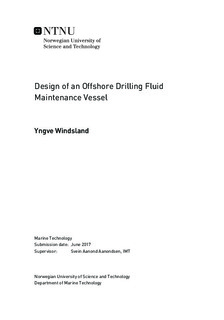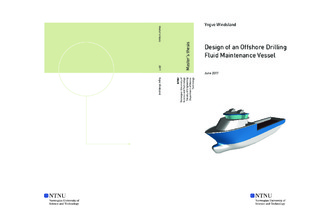| dc.description.abstract | This thesis aims to design an offshore drilling fluid maintenance vessel to increase reuse and recycling of drilling fluids. Large quantities of drilling fluids are used during drilling operations and both transport and procurement of drilling fluids are expensive. By performing maintenance of drilling fluids offshore, less transportation and procurement of the highly valuable fluid are needed and thus a potential of overall cost reduction emerges.
In this thesis, offshore drilling operations are studied in the light of drilling fluid maintenance and bulk shipments. A vessel design able to perform drilling fluid maintenance offshore is developed and principal particulars for the vessel is presented. Economic benefits of introducing such vessel design, and current rules and regulations for reuse and recycling of drilling fluids, are not discussed in this thesis.
In this thesis a vessel concept develops by using the system based ship design methodology. Drilling operations, drilling fluid maintenance, and platform supply vessels used to assist drilling operations as dedicated storage vessels, are analyzed to investigate the potential of implementing a drilling fluid maintenance vessel. Based on these analyses a concept design emerges. To aid in the development process of designing a vessel, a three-dimensional model and general arrangement drawings are created to visualize and validate the vessel design. An outline specification of the vessel is presented as a solution to the objective of performing drilling fluid maintenance offshore.
This thesis proposes a vessel design able to perform drilling fluid maintenance offshore. Contaminated drilling fluid, used in a drilling operation, is treated onboard the vessel by a drilling fluid maintenance system. The drilling fluid maintenance system consists of; three solids control units and one centrifuge to clean the contaminated drilling fluid, one mud-mixer to mix additives into the drilling fluid, and storage tanks to store the drilling fluids and components. These systems are connected to a pump and piping system to move the drilling fluid around in the vessel.
Total installed machinery in the vessel is 8700 kW. This power is distributed on three main generators of 2600 kW, one auxiliary generator of 700 kW, and one emergency generator of 200 kW. The main propulsion system consists of two azipull thrusters. In addition, there are two tunnel thrusters and one retractable azimuth thruster in the bow. Accommodation capacity for the vessel is 25 persons distributed on 19 cabins, where 13 of them are single cabins intended for the crew and 12 double cabins intended for clients.
The vessel length over all is 91,5 meters and the breadth is 20,5 meters. Total displacement for the vessel is 9670 tonnes and the deadweight tonnage is 6295 tonnes. Total drilling fluid tank capacity is 1612 m3 and a total of 1690 m3 water ballast tanks are placed in the hull to adjust vessel trim and heeling when loaded. The vessel design complies with the International Maritime Organization requirements for intact stability for the loading conditions presented. However, more loading conditions should be tested to ensure that the vessel is sufficiently safe.
Large uncertainties regarding the quality of the contaminated drilling fluid makes it difficult to determine the performance of the drilling fluid maintenance system and is therefore not identified in this thesis. Methods based on simulation could be utilized to address these issues in further development of the concept. However, experience from a similar concept, Safe Scandinavia, shows that drilling fluid maintenance performed offshore, significantly reduce transport of contaminated drilling fluids to shore for maintenance. Similar results may therefore apply for this vessel design, but should be further analyzed.
The vessel design presented is similar to a large platform supply vessel and designed to operate on a fourteen-days long roundtrip. This is due to directions given by Statoil Marine early in the design process. This reduce the overall design space early in the design process. Exploration of the entire design space could drastically change the design and ought to be done to not exclude better designs. To verify the financial feasibility of the vessel concept, an assessment of building cost, operating cost, required freight rate, and profitability should be done. This could be used to guide the design towards better solutions. The vessel design presented can however be used as a template or reference vessel for further development of the drilling fluid maintenance vessel concept. | |

